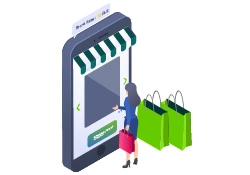Inventory on the Edge: SaaS‑Driven Bin‑Level Stock Automation for Pop‑Up Retail

The retail landscape has shifted, not gradually, but in sharp, scene-stealing moves. Pop-up stores, once seen as novelty plays or marketing gimmicks, have become serious business. Brands are deploying temporary retail spaces to test markets, launch collections, and drive experiential engagement. Retail brands are also incorporating short-term locations into their omnichannel strategy.
But behind the buzz lies a serious systems problem. Traditional inventory infrastructure, designed for permanence, stability, and long planning cycles, falters in the kinetic, high-pressure world of mobile retail. Spreadsheets don’t scale, barcodes don’t always scan, and manual counts fail when inventory turns over in hours, not days.
So, the question sharpens: Can real-time, bin-level stock control solve the chaos? Can precision automation step into the fleeting moment of a pop-up and bring order, insight, and speed?
In this blog, we will explore how modern retailers are addressing the pop-up paradox, examining how bin-level tracking, automation, and intelligent syncing can transform inventory management. From the backroom to the barcode, we’ll show how technology is catching up with the pace of retail innovation, and why it matters now more than ever.

Power your next pop-up with Ginesys precision today
The New Retail Battlefield: Mobility, Micro-Stores, and Milliseconds
A flagship store has the luxury of space, time, and routine. A pop-up, however, is tactical. They drop into high-traffic zones, such as festivals, malls, or airports. They exist for days or weeks, not months. Every inch is optimized, and every product must move. There is no back room for a second chance.
Customer expectations, meanwhile, remain relentless. A shopper doesn’t care if the boutique is temporary; they expect instant access to the item they saw online last night. They want accurate stock visibility, frictionless service, and same-day fulfillment. Anything less, and the brand pays not just in lost sales, but in lost trust.
When you're operating out of a 150-square-foot cube in a subway station, you can’t afford to wonder if the last size 9 sneaker is still in bin 3. You need to know, instantly, remotely, reliably.
And that’s where the future is forming: SaaS-driven, bin-level automation - smart enough to operate in motion, fast enough to keep up with the customer, and precise enough to eliminate doubt.
Bin-Level vs Basic: Why Granularity is the New Gold
Imagine this: you’re running a pop-up cosmetics shop at a music festival. Sales are surging. A customer asks for a specific shade of lipstick. You know you packed 100 units, but which crate is it in? Which shelf? Is it even at this location? Without precise stock visibility, the sale slips away. Multiply that by ten customers a day, and the loss becomes measurable.
That’s where bin-level tracking enters and transforms.
Bin-level tracking tells you exactly where each item is located by mapping every unit to a specific bin, shelf, or storage location and updating it in real-time. SKU-level tracking is like knowing you have 100 books. Bin-level is knowing which 100 books, on which shelf, in which room, and being able to search and retrieve in seconds. In traditional retail, that level of precision is a luxury. In pop-up retail, it’s survival.
Temporary environments frequently face extreme limitations, such as operating in small spaces, narrow windows, or with considerable traffic, where stockouts, overstocking, or misplacements can act as leaks of revenue.
A 2024 Zebra Technologies study discovered that 58% of retailers are still utilizing manual inventory control, which can lead to increased errors and slower replenishment. Retailers using bin-level intelligence, however, eliminated out-of-stocks by as much as 30% with proactive replenishment alerts and item-specific accuracy.
In settings where every wasted minute is wasted margin, granular location data is key. Especially when taking pop-ups to different cities, venues, or events, knowing what’s in stock and exactly where it’s held make or break the pop-up shop.

Don’t risk stockouts, let Ginesys fuel your pop-up.
SaaS-Powered Agility: Inventory in Real-Time, Anywhere
If bin-level visibility is the eyes, SaaS-powered platforms are the brain quietly orchestrating every move behind the scenes. By providing intelligence and speed to meet pop-up retail demands, cloud-based inventory systems transform even the most mobile retail setups into polished, high-tech storefronts. Instead of relying on clunky spreadsheets or periodic stock checks, retailers can now monitor stock levels, shipments, and movements in real time from a single, cloud-hosted dashboard.
Imagine a traveling sneaker drop using a basic inventory list vs. one powered by SaaS. The former risks overselling or understocking. The latter? It syncs live with payment systems, updates inventory across all platforms instantly, and auto-notifies staff when replenishment is needed.
Retailers that have adopted SaaS inventory systems have found that they could lower their operating costs by 25–30% (as reported by McKinsey & Company in 2024) and can reduce missed fulfillment orders by as much as 40%. These systems are able to connect with POS, RFID, mobile, and logistics systems, enabling agility that was previously unthinkable for non-permanent stores.
But the real advantage is real-time response. If a pop-up in Delhi is about to run out of a hot product, the SaaS dashboard can instantly flag it and signal for restocking from a nearby warehouse, or possibly rerouting inventory from another event spot. The retailer can respond in minutes, not days. That’s operational elasticity in action.
Today, retail is being shaped by speed, mobility, and micro-locations, and SaaS inventory systems offer not only control, but a competitive advantage. They level the playing field, enabling lean, temporary storefronts to compete with permanent stores in accuracy, responsiveness, and customer experience, without the infrastructure drag.

Omnichannel Sync: One Customer, One Inventory View
A shopper spies a jacket at a weekend pop-up, pulls out the brand’s app to see if it is available in his size, and finds it labeled “in stock.” But when they come back Monday to shop for it online, it is “out of stock.” It occurred because the inventory was not synced. A 2024 McKinsey report boasts that 71% of consumers want cross-channel consistency from brands, while 45% consider inconsistent inventory a “deal breaker” for repeat purchases.
The challenge? Real-time inventory sync across every channel, pop-up, flagship store, e-commerce, and third-party platforms is deeply complex. Each operates on different cycles, systems, and speeds. Lag even by a few minutes, and your inventory picture starts to blur.
Introducing SaaS systems that track inventory not just at the product (or SKU) level, but all the way down to the exact bin, or micro-location. Embracing cloud-based architecture, such systems provide something that legacy ERPs and generic POS systems cannot: a single source of truth.
Let’s break it down:
- The item is tracked at the bin level for immediate movement within each bin.
- Cloud-based APIs mean data can now sync live across every channel without requiring batching/overnight syncing.
- Machine learning algorithms detect anomalies and trigger instant reallocation or flag possible stockouts before they happen.
Case in point: When fashion brand Allbirds implemented real-time inventory visibility across channels in 2023, their stockouts dropped by 20%, and their fulfillment time improved by 30%.
Accuracy Builds Loyalty - How Stock Precision Wins Customers
Customers today don’t see stock systems; they experience them. When a product promised online is unavailable in store, or vice versa, that invisible disconnect erodes trust. In fact, 94% of customers say order accuracy affects their brand loyalty. And 68% will switch brands after just one bad experience.
This is where stock precision transforms from a back-office concern to a front-line advantage. Bin-level SaaS systems know what you have and they know exactly where it is, how much is there, and how fast it’s moving.
Why does that matter?
- Empowered staff: When associates can trust inventory data, they spend less time searching and more time serving.
- Satisfied customers: When the product is where it should be, when it should be, satisfaction rises.
- Drives repeat business: Retailers with 95%+ inventory accuracy enjoy 2x higher customer retention, according to a 2023 report by Deloitte.
Pop-up beauty brand Glossier’s mobile events cut mis-picks by 35% and saw a 17% uplift in customer satisfaction scores during a 2024 pilot campaign by using bin-level SaaS tracking at each location.

Edge-ready retail automation built for pop-ups by Ginesys.
Mobile Setups, Real Challenges
Pop-up retail is fast, flexible, and logistically brutal. You're handed an empty shell of a 10x10 space in a high-traffic location. You're expected to set up shop in less than six hours, manage inventory across dozens of SKUs, and be fully operational by the afternoon rush. Sounds exciting? It’s also a recipe for operational chaos, unless the systems behind the scenes are as agile as the pop-up model itself.
- Challenge #1: Connectivity isn’t guaranteed over 3.4B people lack reliable internet, and even malls/venues often gate or throttle Wi-Fi, crippling real-time POS and inventory systems.
- Challenge #2: Pop-ups can’t afford storage buffers; every square foot must generate revenue, so one misplaced SKU equals a lost sale.
- Challenge #3: Pop-ups must launch in hours, not days—brands need logistics, staff, and stock ready on short notice without lengthy onboarding or setup.
So how does bin-level stock automation, powered by SaaS, meet these challenges head-on?
- Offline-first Design: The best SaaS solutions today offer robust offline functionality. That means transactions, stock tracking, and bin-level updates don’t grind to a halt when the signal drops. Data syncs the moment connectivity is restored.
- Hyperlocal Stock Intelligence: Bin-level inventory means every unit is tracked by location, SKU, and bin. These systems integrate with smart labels, RFID tags, or barcode scanners, enabling precise visibility even in spatially limited environments. This removes the guesswork, eliminates overstocking, and allows pop-ups to operate lean without losing control.
- Plug-and-Play Infrastructure: No servers, no wiring, just a tablet, a barcode scanner, and a connected SaaS dashboard. These systems can be deployed in under an hour, managed by staff with minimal training, and scaled across multiple locations.

Launch faster, sell smarter, scale stronger with Ginesys.
Retailers Rewriting the Rulebook: Adopting Agile Inventory Tools
Legacy retail systems were built for permanence, not for pop-ups. But permanence no longer defines retail success; agility does.
In 2025, brands from Nike to Glossier are launching micro-retail formats at record speed. According to CBRE’s 2024 Retail Trends Report, 47% of global retailers now use temporary or pop-up formats as part of their core strategy. This shift demands a parallel transformation in the tools that power those operations.
Traditional ERP systems, once the default, are increasingly seen as anchors. For a retailer testing five new pop-up concepts in five cities, a heavy tech stack is a non-starter. Instead, agile SaaS platforms are the new backbone. These tools are modular, cloud-based, and device-agnostic. Crucially, they offer:
- Real-time stock visibility at the bin level
- Auto-sync across locations and warehouses
- Mobile-first dashboards for remote management
- Integrations with low-code/no-code tools for fast deployment
Imagine a DTC apparel brand planning a pop-up at a music festival this weekend. They've booked a 200 sq ft tent, have no onsite storage, and expect footfall of 3,000 per day. Using a bin-level SaaS inventory system, they:
- Pre-bundle SKUs into mobile bins.
- Tag each bin with a unique code tied to live inventory.
- Load data into a mobile POS with offline-first SaaS software.
- Launch with zero local infrastructure and full operational transparency.
Stockouts are tracked in real time, high-sellers are flagged instantly, and replacement stock is dispatched dynamically from the nearest micro-warehouse.
This isn’t just tech adoption; it’s a mindset shift. Retailers embracing agile inventory are no longer bound by square footage or fixed installations. They can launch anywhere, scale instantly, and deliver high-touch customer experiences without logistical drag. With SaaS and bin-level intelligence, inventory moves from being a liability to a strategic asset.
The Game-Changer Behind the Curtain: Ginesys Powers the Pop-Up Revolution
Behind every seamless pop-up, whether it’s a limited-time sneaker drop, a flash sale fashion kiosk, or a one-day gourmet food stall, lies a silent powerhouse orchestrating chaos into order. That powerhouse isn’t a vendor or a plug-and-play tool; it’s Ginesys, the quiet hero of India’s pop-up retail revolution. Imagine a brand launching a week-long pop-up across five cities: inventory must be split, tracked, and sold with zero error; returns handled in real time; and sales data synced instantly across teams — all on infrastructure that sets up and tears down effortlessly. Who makes that possible? Ginesys does. Let’s understand how:
The Power to Operate on the Edge
Pop-up retail is unforgiving. Inventory can’t be “mostly” accurate, or operations can’t “probably” sync. At the edge of traditional supply chains, the slightest misstep can mean stockouts, overages, or customer dissatisfaction.
Ginesys meets this challenge with precision engineering. Its SaaS POS system is built mobility-first, not as an afterthought. It runs anywhere, even in transient setups with unpredictable network conditions. It's tailor-made for the edge, and it doesn’t just operate there; it thrives.
Bin-Level Clarity in a World of Movement
In fast-moving retail environments, visibility is everything. Ginesys empowers brands with bin-level inventory tracking, enabling SKU-level accountability across locations, events, and bins.
Need to locate that one size-M jacket in a sea of cartons? Ginesys has already tracked it, logged it, and prepped it for checkout. This is not warehouse-grade intelligence scaled down; it’s built from the ground up for agility.
Unified, Streamlined, Reliable
Most vendors offer POS, some offer ERP, and a few can handle inventory management. Ginesys offers all three on a single unified SaaS platform. It eliminates data silos and human error. It ensures every sale, return, and stock transfer is automatically reconciled in one system.
With real-time sync across multiple retail locations, brands using Ginesys don’t just keep up, they anticipate. This capability is particularly vital for pop-ups, where inventory accuracy is non-negotiable and mistakes are public.
Ginesys in the Field: A Trust Built Across Indian Retail
Ginesys isn’t new to the game. It’s trusted by over 1200+ retail brands across India, including Manyavar, Biba, Soch, and Mufti. Its credibility is earned through execution. Ginesys has powered everything from national retail chains to emerging D2C brands as they scale through pop-ups, omni-channel commerce, and hyperlocal activations.
Ginesys reimagines the entire stack, mobile-first, cloud-native, and event-ready. Where others see friction, Ginesys builds function. Where others bolt on fixes, Ginesys architects solutions. It doesn’t just support pop-up retail; it powers it from the inside out.

What’s Next: The Future of Event Retailing
At the heart of this transformation is AI-powered predictive inventory. Modern SaaS retail platforms embed machine learning algorithms that ingest historical sales, weather forecasts, footfall projections, and social media sentiment to predict stock requirements with stunning accuracy. According to a 2024 Gartner report, retailers using AI for demand forecasting reduce stockouts by up to 50% and overstocking by nearly 30%.
Traditional demand planning tools weren’t designed for such fluidity, but newer AI-driven platforms are. They can simulate dozens of scenarios before the event begins, fine-tune live during operations and learn afterward for the next deployment.
But forecasting is only one side of the equation; fulfillment has to match that intelligence. That’s where hyper-local edge fulfillment centers come in. We’re seeing a quiet logistics revolution: micro-warehouses now live inside urban retail hubs, parking garages, even repurposed containers. Their proximity means inventory can be restocked during the event itself.
This all leads to a radical reimagining of inventory itself: as an on-demand utility. Retailers may not "own" permanent inventory stockpiles for events. Instead, they’ll plug into decentralized, SaaS-orchestrated inventory grids that route stock as needed, billed like a service.
In this future, inventory isn’t static; it flows, anticipates, and adapts. Just like the retailers it supports.

Transform fleeting retail sparks into lasting brand brilliance with Ginesys
Final Word: Rethink the Edge
For years, edge retail was considered a compromise, what you did when you couldn’t access centralized logistics or full-scale infrastructure. But when SaaS platforms give you bin-level visibility, real-time cloud sync, and autonomous stock movement, the edge becomes a high-performance zone.
Companies like Ginesys, along with other advanced SaaS providers, are shaping this shift. With integrated POS, warehouse, and fulfillment tools built for precision, they’re turning every stock movement into a strategic decision.
Ready to turn your next pop-up into a performance powerhouse? Discover how Ginesys can help.
